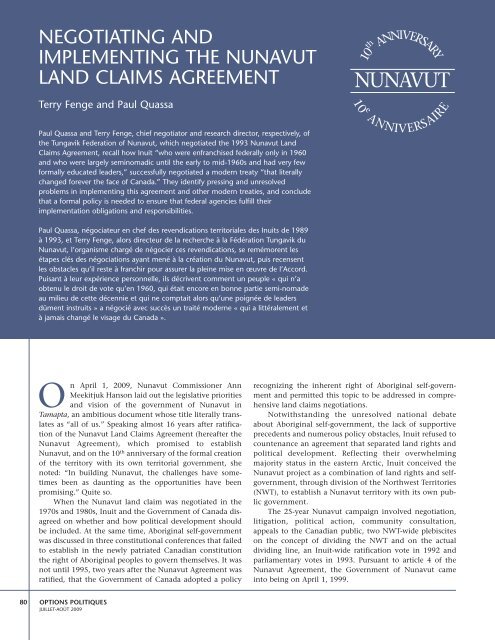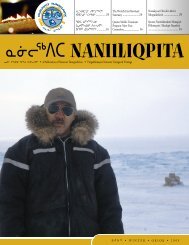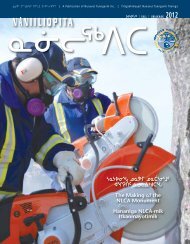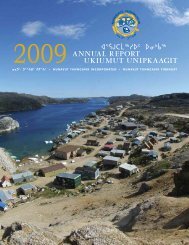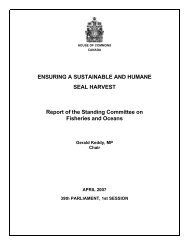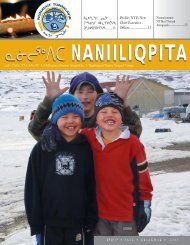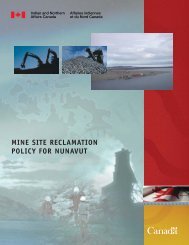Negotiating and implementing the Nunavut Land Claims Agreement
Negotiating and implementing the Nunavut Land Claims Agreement
Negotiating and implementing the Nunavut Land Claims Agreement
- No tags were found...
You also want an ePaper? Increase the reach of your titles
YUMPU automatically turns print PDFs into web optimized ePapers that Google loves.
●●●●●●●There were close <strong>and</strong> cooperativerelations between staff,many of whom were kabloona(white), <strong>and</strong> Inuit politicians<strong>and</strong> negotiators.The parties were willing to compromiseon issues <strong>the</strong> Governmentof Canada considered to bematters of principle, such as <strong>the</strong>Crown retaining title to most of<strong>the</strong> subsurface, <strong>and</strong> <strong>the</strong> boundaryseparating <strong>the</strong> Inuit <strong>and</strong> Denel<strong>and</strong> claims settlement areas.A forward-looking <strong>and</strong> practicalapproach was adopted that aimedto avoid embarrassing <strong>the</strong> Governmentof Canada forpast mistakes, such as <strong>the</strong>involuntary relocation ofInuit from nor<strong>the</strong>rn Quebecto <strong>the</strong> High Arcticisl<strong>and</strong>s in <strong>the</strong> 1950s, butra<strong>the</strong>r to use negotiationsto plan a positive futurefor Inuit within <strong>the</strong> Canadianframework. Inuit suggested<strong>the</strong>y were joiningCanada at a time whenmany in Quebec said <strong>the</strong>ywanted to leave.The focus was concentratedon <strong>the</strong> <strong>Nunavut</strong> projectthrough <strong>the</strong> establishmentof TFN, whose m<strong>and</strong>ate<strong>and</strong> sole purpose wasto negotiate an agreementwith <strong>the</strong> Government ofCanada.There was a willingness <strong>and</strong> abilityto draft provisions <strong>and</strong> respondquickly to <strong>the</strong> positions of <strong>the</strong>Government of Canada in order to“drive” <strong>the</strong> negotiating process.Relatively few third-party rights<strong>and</strong> interests to l<strong>and</strong> <strong>and</strong> naturalresources were subject tonegotiation.The process was aided by <strong>the</strong> factthat in 1986 <strong>the</strong> Government ofCanada adopted a ComprehensiveL<strong>and</strong> <strong>Claims</strong> Policy that broadened<strong>the</strong> rights <strong>and</strong> benefits <strong>and</strong>narrowed <strong>the</strong> requirement to cedeAboriginal title through negotiatedagreements.<strong>Negotiating</strong> <strong>and</strong> <strong>implementing</strong> <strong>the</strong> <strong>Nunavut</strong> L<strong>and</strong> <strong>Claims</strong> <strong>Agreement</strong>We suggest, as well, that <strong>the</strong>Government of Canada’s negotiatorsapproached <strong>the</strong>ir task withprofessionalism, diligence <strong>and</strong>creativity. While ministers of Indianaffairs <strong>and</strong> nor<strong>the</strong>rn developmentcame <strong>and</strong> went during <strong>the</strong> 1980s,<strong>the</strong> federal chief negotiator, TomMolloy, a Saskatoon-based lawyer,<strong>and</strong> <strong>the</strong> senior negotiator, BarryDewar, a career civil servant, stayedwith <strong>the</strong> process for years, providingcontinuity <strong>and</strong> corporate memorythat spanned <strong>the</strong> governments ofdifferent political persuasions.Ottawa’s close attention wasrequired if <strong>the</strong> <strong>Nunavut</strong> projectwas to move in a reasonable amountof time from an agreement in principleto a final agreement. In thatsense, <strong>the</strong> collapse of <strong>the</strong>Dene/Métis Final <strong>Agreement</strong> in 1990probably assisted Inuit in that itbrought <strong>the</strong> <strong>Nunavut</strong> project to centrestage at a time when policy-makersin Ottawa needed to providedirection on <strong>the</strong> issue of politicaldevelopment.We suggest, as well, that <strong>the</strong>Government of Canada’s negotiatorsapproached <strong>the</strong>ir task with professionalism,diligence <strong>and</strong> creativity.While ministers of Indian affairs <strong>and</strong>nor<strong>the</strong>rn development came <strong>and</strong>went during <strong>the</strong> 1980s, <strong>the</strong> federalchief negotiator, Tom Molloy, aSaskatoon-based lawyer, <strong>and</strong> <strong>the</strong> seniornegotiator, Barry Dewar, a careercivil servant, stayed with <strong>the</strong> processfor years, providing continuity <strong>and</strong>corporate memory that spanned governmentsof different political persuasions.On <strong>the</strong> ratification of <strong>the</strong><strong>Nunavut</strong> <strong>Agreement</strong>, Molloy correctlycharacterized <strong>the</strong> agreement as an“achievement shared.”The <strong>Nunavut</strong> project also benefitedfrom personal commitment on<strong>the</strong> part of key federal politicians(although this is difficult to evaluate).David Crombie, for example,was a keen <strong>Nunavut</strong> supporter duringhis tenure from 1984 to 1986 as ministerof Indian affairs <strong>and</strong> nor<strong>the</strong>rndevelopment. His successor, BillMcKnight, obtained cabinet approvalfor reforms to <strong>the</strong> l<strong>and</strong> claims policythat were first proposed by Crombie,including <strong>the</strong> application of provisionsto <strong>the</strong> offshore, without which<strong>the</strong> <strong>Nunavut</strong> <strong>Agreement</strong> could nothave been finalized.Tom Siddon, ano<strong>the</strong>r Indianaffairs <strong>and</strong> nor<strong>the</strong>rn developmentminister, signed <strong>the</strong> <strong>Nunavut</strong>agreement in principle inIgloolik in April 1990. Seekingto build connections withhim, Inuit leaders took him<strong>and</strong> his spouse out on <strong>the</strong>l<strong>and</strong>, where <strong>the</strong>y slept on caribouskins in an iglu on <strong>the</strong> seaice. On his return, he had supperwith Inuit leaders <strong>and</strong> told<strong>the</strong>m that <strong>the</strong>y could counton his ongoing support for<strong>the</strong>ir project. He was still ministerin 1993, <strong>and</strong> he personallycalled Prime Minister BrianMulroney to recommend that<strong>the</strong> Government of Canadasupport both <strong>the</strong> l<strong>and</strong> rights<strong>and</strong> <strong>the</strong> political developmentprovisions of <strong>the</strong> final agreement.In 2005 he told one of<strong>the</strong> co-authors of this articleof <strong>the</strong> importance of this experienceon <strong>the</strong> l<strong>and</strong> <strong>and</strong> of his deep respectfor <strong>the</strong> Inuit leaders, negotiators <strong>and</strong>elders. Clearly, personal relationscount for something in <strong>the</strong> world ofpolicy, legislation <strong>and</strong> negotiations.Many urban Canadians whohave never been to <strong>the</strong> North have apositive or stereotypical image ofInuit that, in a very general sense,supported <strong>the</strong> Inuit intent to negotiatean agreement on l<strong>and</strong> rights <strong>and</strong>political development. Inuit leaderscharacterized <strong>the</strong>mselves as proudCanadians who support Canada’sArctic sovereignty, which contributedto this image. Indeed, <strong>the</strong>POLICY OPTIONSJULY-AUGUST 200983
<strong>Negotiating</strong> <strong>and</strong> <strong>implementing</strong> <strong>the</strong> <strong>Nunavut</strong> L<strong>and</strong> <strong>Claims</strong> <strong>Agreement</strong><strong>Nunavut</strong> Tunngavik Inc.Paul Quassa, President of <strong>the</strong> Tungavik Federation of <strong>Nunavut</strong>, <strong>and</strong> Brian Mulroney, Prime Minister of Canada, hold up <strong>the</strong> signed<strong>Nunavut</strong> L<strong>and</strong> <strong>Claims</strong> <strong>Agreement</strong>, on May 25, 1993. They are flanked by John Amagoalik, Titus Allooloo, Indian Affairs minister TomSiddon, James Eetoolook, <strong>and</strong> Nellie Cournoyea, Premier of <strong>the</strong> Northwest Territories.<strong>and</strong> obligations, disputes over funding,a lack of collaboration <strong>and</strong> <strong>the</strong>absence of a process to monitorimplementation. Once again, it recommendsreinvigorating <strong>the</strong><strong>Nunavut</strong> Implementation Panel <strong>and</strong>,tellingly, it urges <strong>the</strong> Government ofCanada to increase its implementationaccountability, saying: “Theissue of trust, at least in terms oftrusting <strong>the</strong> Government of Canada,is that <strong>the</strong> process itself conveys nocertainty or accountability to <strong>the</strong>parties involved in working throughproblems <strong>and</strong> developing solutions.”The renegotiation <strong>and</strong> renewal of<strong>the</strong> implementation contract tocover <strong>the</strong> period 2003 to 2013 hasproved painful <strong>and</strong> unsuccessful,leading some to suggest that <strong>the</strong> Governmentof Canada had virtually lostinterest in <strong>implementing</strong> <strong>the</strong><strong>Nunavut</strong> <strong>Agreement</strong> <strong>and</strong> was concentratingon negotiations elsewhere. Itwas frequently alleged that <strong>the</strong>Department of Indian Affairs <strong>and</strong>Nor<strong>the</strong>rn Development (DIAND)could not get o<strong>the</strong>r federal agenciesto fulfill <strong>the</strong>ir obligations under <strong>the</strong>agreement. <strong>Nunavut</strong> TunngavikIncorporated (NTI), <strong>the</strong> Inuit organization<strong>implementing</strong> <strong>the</strong> <strong>Nunavut</strong><strong>Agreement</strong>, suggested that <strong>the</strong> m<strong>and</strong>ateof <strong>the</strong> federal government’simplementation contract negotiatorwas inadequate <strong>and</strong> was, in anyevent, committed to <strong>the</strong> status quo of<strong>the</strong> first implementation contractcovering 1993 to 2003.The federal government’s blanketrefusal to agree to arbitrate disputes, asprovided for in <strong>the</strong> agreement, epitomizeda growing gap between it <strong>and</strong>NTI. Conciliation by former justiceThomas Berger in 2006 proved unsuccessful.NTI agreed to it but <strong>the</strong>Government of Canada never formallyresponded to his report, which recommendeda vigorous commitment tobilingual Inuktitut/English educationto enable Inuit to develop <strong>the</strong> capacityto fully benefit from <strong>the</strong> <strong>Nunavut</strong><strong>Agreement</strong>.In 2003 NTI was instrumental in<strong>the</strong> formation of a coalition of FirstNations <strong>and</strong> Inuit organizations thathad modern treaties to jointly press<strong>the</strong> federal government to adopt a policyto fully implement comprehensivel<strong>and</strong> claims agreements <strong>and</strong> to alter<strong>the</strong> machinery of government toensure <strong>the</strong> adoption of “whole of government”approaches. In 2004 NTIpetitioned <strong>the</strong> Commissioner of Environment<strong>and</strong> Sustainable Develop-POLICY OPTIONSJULY-AUGUST 200985
Terry Fenge <strong>and</strong> Paul Quassament in <strong>the</strong> Office of <strong>the</strong> Auditor Generalof Canada to examine <strong>the</strong> failureon <strong>the</strong> part of DIAND to implement<strong>the</strong> environmental <strong>and</strong> socio-economicmonitoring provisions of <strong>the</strong> agreement.Soon afterward, a formal auditof implementation of <strong>the</strong> Gwich’in,<strong>Nunavut</strong> <strong>and</strong> Sahtu agreements by <strong>the</strong>auditor general of Canada supported<strong>the</strong> coalition’s analysis <strong>and</strong> position.In <strong>the</strong> second half of 2005 representativesof <strong>the</strong> coalition met regularlywith representatives of federalagencies to jointly draft an implementationpolicy. These negotiationswere terminated by <strong>the</strong> new governmentimmediately following <strong>the</strong>January 2006 federal election. TheSenate Committee on AboriginalAffairs held formal hearings in late2007 <strong>and</strong> early 2008 into <strong>the</strong> implementationof modern treaties. Thecommittee heard <strong>the</strong> same story ofunfulfilled obligations <strong>and</strong> foot-draggingby <strong>the</strong> Government ofCanada from each <strong>and</strong>every coalition member.NTI was a particularlyprominent <strong>and</strong> volublewitness.These various experiencesprompted NTI to file a lawsuit in<strong>the</strong> <strong>Nunavut</strong> Court of Justice inDecember 2006 seeking $1 billion indamages for alleged breach of contractby <strong>the</strong> Government of Canada.NTI’s statement of claim, posted onits Web site, is very broad <strong>and</strong> reflects<strong>the</strong> Inuit view of <strong>the</strong> substantive, procedural,financial <strong>and</strong> o<strong>the</strong>r failures by<strong>the</strong> Government of Canada to fulfill itsduties <strong>and</strong> obligations, which were sopainfully <strong>and</strong> meticulously negotiatedfrom <strong>the</strong> late 1970s to <strong>the</strong> early 1990s.NTI President Paul Kaludjak did notmince words when filing <strong>the</strong> suit:The Government of Canadakeeps Inuit dependent <strong>and</strong> in astate of financial <strong>and</strong> emotionaldespair despite promises madewhen <strong>the</strong> <strong>Nunavut</strong> <strong>Agreement</strong>The <strong>Nunavut</strong> <strong>Agreement</strong> was a triumph of political statecraft,<strong>and</strong> while much has been accomplished, its full promise hasnot been realized. In 1993 <strong>the</strong> expectations that <strong>the</strong> <strong>Nunavut</strong><strong>Agreement</strong> would “solve” difficult social <strong>and</strong> economicproblems were probably too great. Never<strong>the</strong>less, <strong>the</strong>agreement does provide many tools that <strong>the</strong> Inuit of <strong>Nunavut</strong>,<strong>the</strong> Government of <strong>Nunavut</strong> <strong>and</strong> <strong>the</strong> Government of Canadacan apply to address challenging public policy issues.was signed in 1993. TheGovernment of Canada is notholding up its end of <strong>the</strong> bargain.Canada got everything itwanted immediately upon signing<strong>the</strong> <strong>Nunavut</strong> <strong>Agreement</strong>.Inuit are still waiting for fullimplementation of <strong>the</strong><strong>Agreement</strong>.The <strong>Nunavut</strong> <strong>Agreement</strong> was a triumphof political statecraft, <strong>and</strong>while much has been accomplished,its full promise has not been realized.In 1993 <strong>the</strong> expectations that <strong>the</strong><strong>Nunavut</strong> <strong>Agreement</strong> would “solve”difficult social <strong>and</strong> economic problemswere probably too great.Never<strong>the</strong>less, <strong>the</strong> agreement does providemany tools that <strong>the</strong> Inuit of<strong>Nunavut</strong>, <strong>the</strong> Government of<strong>Nunavut</strong> <strong>and</strong> <strong>the</strong> Government ofCanada can apply to address challengingpublic policy issues.The agreement is best viewed as amarriage <strong>and</strong> not a divorce between<strong>the</strong> Inuit of <strong>Nunavut</strong> <strong>and</strong> Canada,<strong>and</strong> like all marriages, it requires care,attention <strong>and</strong> commitment on <strong>the</strong>part of both partners. It is difficult,however, to see how <strong>the</strong> agreementcan be used to full advantage unless<strong>and</strong> until <strong>the</strong> Government of Canadadepartments that have implementationobligations commit <strong>the</strong>mselvesfirmly to achieve <strong>the</strong>m, <strong>and</strong> do so ina co-ordinated way.Whe<strong>the</strong>r <strong>the</strong> Departmentof Indian Affairs <strong>and</strong>Nor<strong>the</strong>rn Developmenthas <strong>the</strong> ability <strong>and</strong> clout inOttawa to ensure a “wholeof government” approachneeded to implement <strong>the</strong><strong>Nunavut</strong> <strong>Agreement</strong> <strong>and</strong>o<strong>the</strong>r modern treaties isvery much an open question.Certainly <strong>the</strong> L<strong>and</strong><strong>Claims</strong> <strong>Agreement</strong> Coalition concludesthat it does not, <strong>and</strong> it recommendsan independent agency beestablished through a cabinetapprovedmodern treaty implementationpolicy to persuade, encourage<strong>and</strong> cajole federal departments toimplement modern treaties <strong>and</strong> toaudit <strong>and</strong> report on <strong>the</strong>ir performance.Without this type of policycommitment, modern treaties,including <strong>the</strong> <strong>Nunavut</strong> <strong>Agreement</strong>,are unlikely to be fully implemented.Terry Fenge is a consultant who workspart time for <strong>Nunavut</strong> TunngavikThe agreement is best viewed as a marriage <strong>and</strong> not a divorcebetween <strong>the</strong> Inuit of <strong>Nunavut</strong> <strong>and</strong> Canada, <strong>and</strong> like allmarriages, it requires care, attention <strong>and</strong> commitment on <strong>the</strong>part of both partners.Incorporated, <strong>the</strong> Inuit organization<strong>implementing</strong> <strong>the</strong> <strong>Nunavut</strong> <strong>Agreement</strong>.From 1985 to 1993, he was director ofresearch for Tungavik Federation of<strong>Nunavut</strong> (TFN), <strong>the</strong> Inuit organizationthat negotiated <strong>the</strong> agreement. The formermayor of Igloolik, Paul Quassa,joined TFN in 1985, <strong>and</strong> from 1989 to1993 he was TFN’s chief negotiator.The views <strong>and</strong> perspectives expressed inthis article reflect <strong>the</strong> personal opinionsof <strong>the</strong> authors.86OPTIONS POLITIQUESJUILLET-AOÛT 2009


